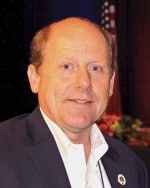The incident earlier this month in which a two-person crew helped to save a 5-year-old girl in his state reminded SMART Transportation Division Minnesota State Legislative Director Phillip Qualy of a letter his state’s legislative board submitted in 2018 in response to a federal Department of Transportation request for comment about autonomous rail operations.
“This was a good letter that our members should read and be aware of,” Qualy said. “This spells out the essential argument of why having two people on the crew is important.”
In the letter, Qualy reminds Batory that technology does not always reduce the tasks involved in operating a train, citing crew duties such as:
- Throwing manual switches and dual control switches, coupling cars, coupling air-hoses, setting hand brakes, pulling pin lifters to switch cars, replacing failed hoses, gaskets, replacing couplers, mechanical and air-brake inspections remain constant work tasks of any operation. Any ATT, PTC, and/or aerial drone cannot do these train tasks.
- When ATT and PTC programs fail en route, standing or delayed trains must not be permitted to block public roadways as a practice. The uncoupling of a standing train to open a grade crossing to allow vehicles to pass requires two persons.
- After grade crossing collisions with the public, immediate Samaritan response to help the injured is an essential and moral responsibility within the fabric of our society. Two persons on all trains are necessary to assist the public after grade-crossing and other accidents.
“The railroad carriers and their associations claim two persons will not be necessary on trains with ATT and/ or PTC,” Qualy wrote. “These technological control features have nothing to do with the necessary and essential tasks of the train-machine behind or ahead of the locomotives.”
The Feb. 1 incident in East St. Paul, Minn., in which a missing girl was found by a two-person train crew after they alertly stopped and provided aid is a perfect example of why two sets of eyes are needed in the cab.
“Railroad carriers have a moral responsibility to provide for the right of Samaritan response,” Qualy wrote in his letter.
The questions need to be asked. Would the girl have been seen if it were a one-person operation that night? Would the sensors of an autonomous train have detected her, stopped the train and invited her into the cab of the locomotive for warmth and protection and then contacted authorities so she could be reunited with her worried family?
Here’s a little reminder that some on the railroad believe in moral responsibility over innovation.
Read SLD Qualy’s letter.

 In light of the recent furloughs by BNSF and Union Pacific railroads, and since many locals are experiencing difficulty reaching the members who have been furloughed and dislocated, the SMART TD Minnesota State Legislative Board is hosting, in conjunction with the Minnesota Department of Education and Economic Development (MN DEED) a free informational meeting to assist those furloughed workers on Monday, August 17, 2015 at 7:00 p.m. in the Minneapolis United Labor Center, Room 218 (located at 312 Central Avenue, S. E., Room 218, Minneapolis, MN 55414). Parking is free.
In light of the recent furloughs by BNSF and Union Pacific railroads, and since many locals are experiencing difficulty reaching the members who have been furloughed and dislocated, the SMART TD Minnesota State Legislative Board is hosting, in conjunction with the Minnesota Department of Education and Economic Development (MN DEED) a free informational meeting to assist those furloughed workers on Monday, August 17, 2015 at 7:00 p.m. in the Minneapolis United Labor Center, Room 218 (located at 312 Central Avenue, S. E., Room 218, Minneapolis, MN 55414). Parking is free.